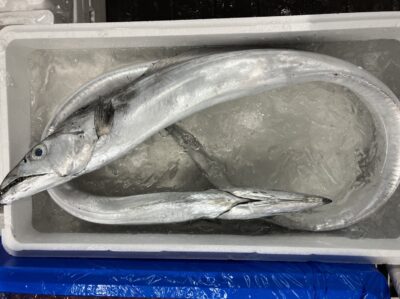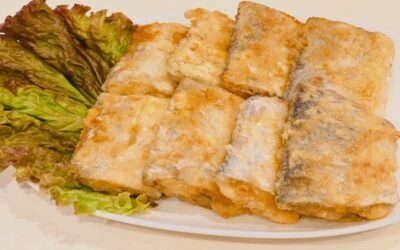2023.07.07
鮮魚情報
Ghost fish “Cutlass fish”
Cutlass fish is called and named “Tachiuo” in Japan for its resemblance to a sword and for the fact that it treads water.
And it has another name “Ghost fish” because it is invisible to the radar as it swims. (Various theories exist)

Cutlass fish has no scales on its long and thin body, and its whole body is covered with pigment called guanine.
This guanine is surprisingly used in some familiar products around you, such as lame nail polish.
Cutlass fishes live in the Sea of Japan between the coasts of Hokkaido and the southern coast of Kyushu, the Pacific Ocean, the Seto Inland Sea and overseas on the Korean Peninsula and the coasts of China.
Cutlass fish is one of the most popular fish overseas because it is caught through the year.
We have exported it to USA, Thailand, Singapore etc. all year round.
At Toyosu market, we often see basically 1kg - 1.5g size the most.
The easiest and tastiest way to eat this fish is to grill it with salt and it is the most common recipe in Japan.
In China and Korea, it is also often grilled with salt.
In addition to salt-grilling, there are many other ways to eat cutlass fish such as simmering and baking the meat with egg, etc.

Some of you may eat cutlass fish as sashimi, but please check it carefully before eating because it is inhabited by anisakis parasites, which are commonly found in live seafood. Therefore, we will recommend heating enough because anisakis is easily affected by heat.
Cutlass fish is a rare fish that contains more fat than protein. It is rich in DHA and EPA, which reduce neutral fat and bad cholesterol in the blood and has the effect of helping our blood flow more smoothly, and is rich in vitamins A, D, and E, which may help prevent lifestyle-related diseases that plague many people of today.
On the other hand, it is high in calories, so be careful not to eat too much.
How to choose fresh cutlass fish
Select fish with no defects on its surface and with guanine remaining on the surface as much as possible.
A brownish discoloration is a sign that the fish is no longer fresh, so check carefully before buying.
【Contact us】
Itabashi Trading Co., Ltd
Food Department
Mr.TAKAYAMA (Japanese, English, German)
TEL :+81-3-3248-1016(Workday 10:00~17:00)
FAX :+81-3-3248-1008
Email: shokuhin@itabashi-trading.com



